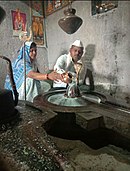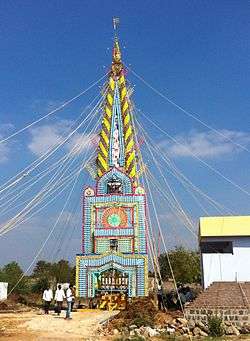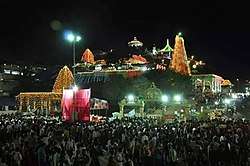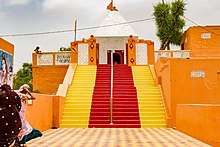Maha Shivaratri
Maha Shivaratri is a Hindu festival celebrated annually in honour of Lord Shiva. The name also refers to the night when Shiva performs the heavenly dance.[4][5] There is a Shivaratri in every luni-solar month of the Hindu calendar, on the month's 13th night/14th day, but once a year in late winter (February/March, or phalgun) and before the arrival of Summer, marks Maha Shivaratri which means "the Great Night of Shiva".[6][7]
| Maha Shivaratri | |
|---|---|
Meditating Lord Shiva statue on Maha-Shivratri | |
| Observed by | Hindus in Bangladesh, Guyana, India, Mauritius, Myanmar, Nepal, Pakistan, Trinidad and Tobago, South Africa |
| Type | Religious |
| Significance | self study, Night of marriage between Shiva and Parvati, yoga[1] |
| Observances | Fasting, yoga, all night vigil, worship of Lingam[1] |
| 2019 date | 4 March (Monday)[2] |
| 2020 date | 21 February (Friday)[3] |
| Frequency | Annual |
| Part of a series on |
| Shaivism |
|---|
 |
|
Scriptures and texts
|
|
Philosophy
|
|
Practices |
|
Schools
Saiddhantika Non - Saiddhantika
|
|
Related
|
It is a major festival in Hinduism, and this festival is solemn and marks a remembrance of "overcoming darkness and ignorance" in life and the world. It is observed by remembering Shiva and chanting prayers, fasting, and meditating on ethics and virtues such as honesty, non-injury to others, charity, forgiveness, and the discovery of Shiva.[7] The ardent devotees keep awake all night. Others visit one of the Shiva temples or go on pilgrimage to Jyotirlingams. This is an ancient Hindu festival whose origin date is unknown.[7]
In Kashmir Shaivism, the festival is called Har-ratri or phonetically simpler Haerath or Herath by Shiva faithfuls of the Kashmir region.[8][9]
Description
During the Vigil Night of Shiva, Mahashivaratri,
we are brought to the moment of interval
between destruction and regeneration;
it symbolizes the night
when we must contemplate on that which
watches the growth out of the decay.
During Mahashivaratri we have to be alone
with our sword, the Shiva out of us.
We have to look behind and before,
to see what evil needs eradicating from our heart,
what growth of virtue we need to encourage.
Shiva is not only outside of us but within us.
To unite ourselves with the One Self
is to recognize the Shiva in us.
—The Theosophical Movement, Volume 72[10]
Maha Shivaratri is an annual festival dedicated to the Hindu god Shiva, and is particularly important in the Shaivism tradition of Hinduism. Unlike most Hindu festivals which are celebrated during the day, the Maha Shivaratri is celebrated at night. Furthermore, unlike most Hindu festivals which include expression of cultural revelry, the Maha Shivaratri is a solemn event notable for its introspective focus, fasting, meditation on Shiva, self study, social harmony and an all night vigil at Shiva temples.[7]
The celebration includes maintaining a "jaagaran", an all-night vigil and prayers, because Shaiva Hindus mark this night as "overcoming darkness and ignorance" in one's life and the world through Shiva. Offerings of fruits, leaves, sweets and milk to Shiva are made, some perform all-day fasting with vedic or tantric worship of Shiva, and some perform meditative Yoga.[11] In Shiva temples, "Om Namah Shivaya", the sacred mantra of Shiva, is chanted through the day.
Maha Shivaratri is celebrated over three or ten days based on the Hindu luni-solar calendar.[6] Every lunar month, there is a Shivaratri (12 per year). The main festival is called Maha Shivaratri, or great Shivaratri, which is held on 13th night (waning moon) and 14th day of the month Phalguna. In the Gregorian calendar, the day falls in either February or March. [6]
History and significance
.jpg)

The Maha Shivaratri is mentioned in several Puranas, particularly the Skanda Purana, Linga Purana and Padma Purana. These medieval era Shaiva texts present different versions associated with this festival, & mention fasting, reverence for icons of Shiva such as the Lingam.[7]
Different legends describe the significance of Maha Shivaratri. According to one legend in the Shaivism tradition, this is the night when Shiva performs the heavenly dance of creation, preservation and destruction.[4][12] The chanting of hymns, the reading of Shiva scriptures and the chorus of devotees joins this cosmic dance and remembers Shiva's presence everywhere. According to another legend, this is the night when Shiva and Parvati got married.[4][13] A different legend states that the offering to Shiva icons such as the linga is an annual occasion to get over past sins if any, to restart on a virtuous path and thereby reach Mount Kailasha and liberation.[4]
The significance of dance tradition to this festival has historical roots. The Maha Shivaratri has served as a historic confluence of artists for annual dance festivals at major Hindu temples such as at Konark, Khajuraho, Pattadakal, Modhera and Chidambaram.[14] This event is called Natyanjali, literally "worship through dance", at the Chidambaram temple which is famous for its sculpture depicting all dance mudras in the ancient Hindu text of performance arts called Natya Shastra.[15][16] Similarly, at Khajuraho Shiva temples, a major fair and dance festival on Maha Shivaratri, involving Shaiva pilgrims camped over miles around the temple complex, was documented by Alexander Cunningham in 1864.[17]
Maha Shivaratri is considered the day when adiyogi or the first guru awakened his consciousness at the material level of existence. According to Tantra, at this stage of consciousness, no objective experience takes place and the mind is transcended. The meditator transcends time, space and causation. It is regarded as the brightest night of the soul, when the yogi attains the state of Shoonya or Nirvana, the stage succeeding samadhi or illumination.
India


Maha Shivaratri is celebrated in Tamil Nadu with great pomp and fanfare in the Annamalaiyar temple located in Tiruvannamalai district. The special process of worship on this day is 'Girivalam'/Giri Pradakshina, a 14-kilometer bare foot walk around Lord Shiva's temple on top of the hill. A huge lamp of oil and camphor is lit on the hilltop at sunset - not to be confused with Karthigai Deepam.
The major Jyotirlinga Shiva temples of India, such as in Varanasi and Somanatha, are particularly frequented on Maha Shivaratri. They serve also as sites for fairs and special events.[18][19]
In Andhra Pradesh and Telangana, Shivratri yatras are held at Mallayya gutta near Kambhalapalle, Gundlakamma Kona near Railway Koduru, Penchalakona, Bhairavakona, Uma Maheswaram amongst others. Special pujas are held at Pancharamas - Amararamam of Amaravati, Somaramam of Bhimavaram, Draksharamam, Kumararama of Samarlakota and Ksheerarama of Palakollu. The days immediately after Shivratri are celebrated as Brahmotsavaalu at Srisailam, one of 12 Jyotirlinga sites. Mahashivaratri utsavalu are held at the Rudreshwara Swamy's 1000 pillar temple in Warangal. Devotees throng for the special poojas at Srikalahasti, Mahanandi, Yaganti, Antarvedi, Kattamanchi, Pattiseema, Bhairavakona, Hanmakonda, Keesaragutta, Vemulawada, Panagal, Kolanupaka amongst others.
The Mandi fair is in the town of Mandi is particularly famous as a venue for Maha Shivaratri celebrations. It transforms the town as devotees pour in. It is believed that all gods and goddesses of the area, said to number more than 200, assemble here on the day of Maha Shivaratri. Mandi, located on the banks of Beas, is popularly known as the "Cathedral of Temples" and one of the oldest towns of Himachal Pradesh, with about 81 temples of different Gods and Goddesses on its periphery.[20][21][22]
In Kashmir Shaivism, Maha Shivaratri is celebrated by the Hindus of Kashmir and is called, "Herath" in Kashmiri, a word derived from the Sanskrit word "Hararatri" the "Night of Hara" (another name of Shiva). Shivaratri, regarded as the most important festival of the community, for instance, is celebrated by them on trayodashi or the thirteenth of the dark half of the month of Phalguna (February–March) and not on chaturdashi or the fourteenth as in the rest of the country. The reason for it is that this long drawn festival that is celebrated for one full fortnight as an elaborate ritual is associated with the appearance of Bhairava (Shiva) as a jwala-linga or a linga of flame. It has been described as Bhairavotsava in Tantric texts as on this occasion Bhairava and Bhairavi, His Shakti or cosmic energy, are propitiated through Tantric worship.
According to the legend associated with the origin of the worship, the linga appeared at pradoshakala or the dusk of early night as a blazing column of fire and dazzled Vatuka Bhairava and Rama (or Ramana) Bhairava, Mahadevi's mind-born sons, who approached it to discover its beginning or end but miserably failed. Exasperated and terrified they began to sing its praises and went to Mahadevi, who herself merged with the awe-inspiring jwala-linga. The Goddess blessed both Vatuka and Ramana that they would be worshipped by human beings and would receive their share of sacrificial offerings on that day and those who would worship them would have all their wishes fulfilled. As Vatuka Bhairava emerged from a pitcher full of water after Mahadevi cast a glance into it, fully armed with all his weapons (and so did Rama), he is represented by a pitcher full of water in which walnuts are kept for soaking and worshipped along with Shiva, Parvati, Kumara, Ganesha, their ganas or attendant deities, yoginis and kshetrapalas (guardians of the quarters) – all represented by clay images. The soaked walnuts are later distributed as naivedya. The ceremony is called 'vatuk barun' in Kashmiri, which means filling the pitcher of water representing the Vatuka Bhairava with walnuts and worshipping it.
Central India has a large number of Shaiva followers. The Mahakaleshwar Temple, Ujjain is one of the most venerated shrines consecrated to Shiva, where a large congregation of devotees gathers to offer prayers on the day of Maha Shivaratri. Tilwara Ghat in the city of Jabalpur and the Math Temple in the village of Jeonara, Seoni are two other places where the festival is celebrated with much religious fervour.
In Punjab, Shobha Yatras would be organised by various Hindu organisations in different cities. It is a grand festival for Punjabi Hindus.
In Gujarat, Maha Shivaratri mela is held at Bhavnath near Junagadh where bathing in the Mrugi (Mrigi) kund is considered holy. According to myth, Lord Shiva himself comes to bath in the Mrugi kund.
In West Bengal, Maha Shivaratri is observed devoutly by unmarried girls seeking a suitable husband, often visiting Tarakeswar.
Stories & Beliefs
There are several stories and beliefs associated with this auspicious event.
Samudra Manthan
It is believed that on this particular day Lord Shiva gulped the Halahala produced during Samudra manthan and beheld it in his neck which bruised and turned blue, after which he was named as Neel Kanth. It is also believed that the famous Neelkanth Mahadev Temple is the place where this incident took place.
Nepal
Maha Shivaratri is a National Holiday in Nepal and celebrated widely in temples all over the country, but especially in the Pashupatinath temple. Thousands of devotees visit the famous Shiva Shakti Peetham nearby as well. Holy rituals are performed all over the nation. Artists from various classical music and dance forms perform through the night. On Maha Shivaratri, married women pray for the well being of their husbands, while unmarried women pray for a husband like Shiva, considered as the ideal husband. Shiva is also worshipped as the Adi Guru (first teacher) from whom the divine wisdom originates.
Pakistan

Hindus in Pakistan visit Shiva temples during Shivratri. The most important is the three-day Shivratri festival in the Umarkot Shiv Mandir. It is one of the biggest religious festivals in the country. It is attended by around 250,000 people. All the expenses were borne by the Pakistan Hindu Panchayat.[23] Shivrathri Celebrations also occur in the Churrio Jabal Durga Mata Temple, which is attended by 200,000 pilgrims. Hindus cremate the dead and ashes are preserved till Shivratri for immersion into the holy water in Churrio Jabal Durga Mata Temple. [24]
Outside South Asia
Maha Shivaratri is the main Hindu festival among the Hindu diaspora from the Indian states of Uttar Pradesh and Bihar. In Indo-Caribbean communities, thousands of Hindus spend the beautiful night in over four hundred temples across the country, offering special jhalls (an offering of milk and curd, flowers, sugarcane and sweets) to Lord Shiva.[25] In Mauritius, Hindus go on pilgrimage to Ganga Talao, a crater-lake.[26]
References
- Melton, J. Gordon (2011). Religious Celebrations: An Encyclopedia of Holidays, Festivals, Solemn Observances, and Spiritual Commemorations. ABC-CLIO. pp. 541–542. ISBN 978-1-59884-206-7.
- "National Portal of India". www.india.gov.in. Retrieved 18 December 2019.
- "National Portal of India". www.india.gov.in. Retrieved 18 December 2019.
- Dhoraisingam, Samuel S. (2006). Peranakan Indians of Singapore and Melaka. Institute of Southeast Asian Studies. p. 35. ISBN 978-981-230-346-2.
- Om Prakash Juneja; Chandra Mohan (1990). Ambivalence: Studies in Canadian Literature. Allied. pp. 156–157. ISBN 978-81-7023-109-7.
- Dalal, Roshen (2010). Hinduism: An Alphabetical Guide. Penguin Books. pp. 137, 186. ISBN 978-0-14-341421-6.
- Constance Jones; James D. Ryan (2006). Encyclopedia of Hinduism. Infobase Publishing. p. 269. ISBN 978-0-8160-7564-5.
- Brunn, Stanley D. (2015). The Changing World Religion Map: Sacred Places, Identities, Practices and Politics. Springer. pp. 402–403. ISBN 978-94-017-9376-6.
- Maitra, Asim (1986). Religious Life of the Brahman: A Case Study of Maithil Brahmans. Munshilal. p. 125. ISBN 978-81-210-0171-7.
- "Shiva". The Theosophical Movement (reprint). TEOS, Theosophy Company, Mumbai. 72 (4): 137. 2002 [February 1962].
- Mahashivaratri Archived 27 March 2014 at the Wayback Machine, Government of Orissa; Maha Shivaratri, Public Holidays
- Om Prakash Juneja; Chandra Mohan (1990). Ambivalence: Studies in Canadian Literature. Allied. pp. 156–157. ISBN 978-81-7023-109-7.
- Leuthold, Steven (2010). Cross-Cultural Issues in Art: Frames for Understanding. Routledge. pp. 142–143. ISBN 978-1-136-85455-2.
- Pintchman, Tracy (2007). Women's Lives, Women's Rituals in the Hindu Tradition. Oxford University Press. pp. 194–195. ISBN 978-0-19-803934-1.
- Pintchman, Tracy (2007). Women's Lives, Women's Rituals in the Hindu Tradition. Oxford University Press. pp. 194–196. ISBN 978-0-19-803934-1.
- Pugh McCutchen, Brenda (2006). Teaching Dance as Art in Education. Human Kinetics. p. 450. ISBN 978-0-7360-5188-0.
- Shobita Punja (1999). Khajuraho: the first thousand years. Penguin Books. pp. 71–74.
- Eck, Diana L. (1982). Banras, City of Light. Knopf. pp. 113, 256, 276. ISBN 9780394519715.
- More About Monthly Shivratri: https://www.bhaktibharat.com/en/festival/shivaratri
- "International Shivaratri fair in Mandi". Himachal tourism. Archived from the original on 14 April 2010. Retrieved 8 February 2012.
- "The International Festival". Archived from the original on 1 April 2009. Retrieved 7 February 2010.
- "Mandi – The Seventh Heaven". Archived from the original on 10 April 2011. Retrieved 7 February 2010.
- "The thriving Shiva festival in Umarkot is a reminder of Sindh's Hindu heritage". 27 February 2018.
- "Contractor blasting through Tharparkar temple in search of granite | The Express Tribune". Retrieved 18 December 2019.
- "Trinidad Hindus observe Shivratri amid Carnival Celebration". Repeating Islands. 2 March 2014. Retrieved 31 August 2016.
- "The sacred lake of Ganga Talao". CNN. Retrieved 12 June 2018.


